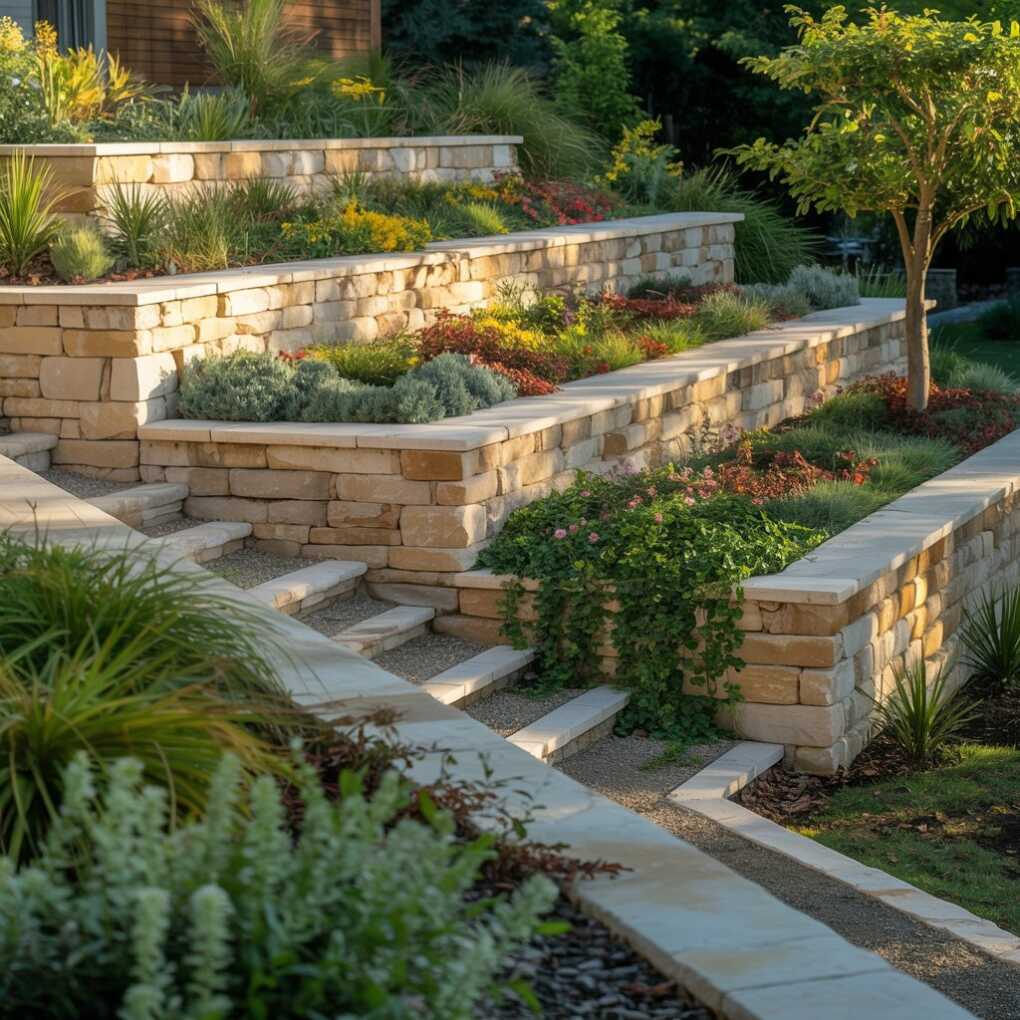
Retaining walls have evolved far beyond their original utilitarian purpose. When thoughtfully designed, retaining walls provide structural support and creative enhancements for gardens, patios, and backyards. Their versatility makes them ideal for addressing challenging slopes and maximizing usable space, while also offering the potential to create stunning architectural focal points in almost any landscape. As outdoor design trends continue to blend environmental consciousness with visual appeal, retaining walls have become an integral part of creating functional, visually engaging spaces. They no longer hold back soil—instead, they shape environments, provide creative opportunities, and solve landscape challenges with style and innovation.
Homeowners and landscape designers now use retaining walls to blend form and function. These walls can be transformed with integrated seating, natural stone veneers, or as a living canvas for plant life. By taking a creative approach, retaining walls add visual interest and become essential features that seamlessly combine strength, style, and outdoor comfort. In many cases, retaining walls offer a visual transition between different levels of a property, softening grade changes while serving as a structural asset. Their adaptability means you can tailor the wall’s appearance, height, and material to your taste and specific landscape needs. Ultimately, a well-considered retaining wall becomes a signature element that elevates aesthetics and improves how a space is enjoyed and navigated.
Multi-Functional Retaining Walls
Retaining walls now often serve dual purposes, blending essential support and versatile functionality for outdoor living spaces. For example, they may be built with integrated benches to create comfortable seating areas beside garden beds or patios, turning the wall from a simple boundary into a social hub for relaxation and gathering. Some designs include fire pits or barbecue stations, transforming a simple structural feature into a vibrant entertainment hub that invites family and friends to linger throughout the seasons. Built-in planters, lighting, or countertop spaces further extend the utility of these walls, turning a single element into a multi-use feature. These inventive uses allow you to maximize space while maintaining a stylish, cohesive outdoor layout. Through creative engineering and design, homeowners can add utility without additional clutter, making every square foot count—especially in compact or challenging yards.
Curved and Layered Designs
Moving beyond bare straight walls, curved retaining walls add fluidity and softness to garden landscapes that might otherwise feel rigid or artificial. The gentle arcs can mirror natural forms, making them perfect for framing flower beds, pathways, or water features like small ponds. By following the land’s natural contours or introducing new, organic lines, curved walls can also make small gardens appear larger or more dynamic. Layered or terracing walls are particularly effective on steep slopes, where a single tall wall might be imposing or impractical. This approach creates a series of mini-gardens or planting terraces, increasing usable ground and introducing multiple levels that draw the eye throughout the landscape. Terraced retaining walls allow for creative planting schemes at each level—flowering perennials at one, herbs or vegetables at another—adding year-round interest and increasing the biodiversity of your garden. By breaking up large slopes into manageable, attractive sections, these designs enhance the beauty, accessibility, and usability of otherwise rugged terrain.
Integrating Water Features
A retaining wall with water features lends tranquility and elegance to any outdoor setting. Waterfalls, wall fountains, or small cascading streams incorporated into the wall’s design deliver visual drama and relaxing sound. These features encourage wildlife such as birds and butterflies, create a peaceful mood, and reflect sunlight for added sparkle. These elements can be designed for both small and large spaces, providing a luxurious ambiance and helping to mask background noise in urban spaces. A bubbling fountain within a stone wall can become the focal point of a courtyard, while a larger waterfall installation can transform a backyard into a private retreat. For design inspiration and best practices, resources like House Beautiful offer ideas for integrating water features in home gardens. With careful planning, water features can help support drainage functions, reduce erosion, and manage stormwater runoff in problematic areas.
Vertical Gardens and Living Walls
Transforming a retaining wall into a vertical garden brings vibrant greenery to limited spaces and creates a striking visual effect. These living walls can support decorative moss, ferns, succulents, or herbs, providing a lush garden look without requiring a large footprint. Modular planters or pockets built directly into the wall offer seasonal flexibility for changing plant selections. In addition to their aesthetic benefits, vertical gardens can help regulate temperatures by acting as natural insulation and improving air quality in your outdoor area while supporting pollinators and beneficial insects. With the right plant choices, a living wall can even serve as a mini herb or vegetable garden, putting fresh ingredients within arm’s reach while maximizing growing area in smaller yards. Native plants, in particular, help conserve water and encourage local wildlife, as the National Wildlife Federation highlights. Living walls also create a sense of privacy or separation without sacrificing natural beauty, making them suitable for city courtyards and spacious suburban yards.
Sustainable Materials and Practices
Eco-friendly building options are an increasing priority for homeowners aiming to create beautiful and responsible outdoor spaces. Recycled materials like reclaimed concrete or timbers provide a unique character with less environmental impact, celebrating sustainability while adding texture and visual interest. Using permeable blocks or gravel instead of traditional non-porous materials reduces stormwater runoff and helps replenish groundwater supplies, benefiting the wider environment. Choosing sustainable methods also extends the life and durability of retaining walls, ensuring they stand up to weather and time. Sourcing materials locally reduces the carbon footprint from transportation and might also save on costs. Integrating rain gardens or bioswales with your retaining wall system can further improve runoff management and foster a healthy ecosystem around your home. By implementing sustainable building practices, you enjoy an attractive landscape upgrade while making a positive environmental contribution for years to come.
Incorporating Technology
Modern retaining wall designs can incorporate innovative technologies that boost sustainability and ease of use. Intelligent irrigation systems installed within or around the wall provide precise moisture for plants, promoting their health and minimizing water waste—especially valuable for homeowners committed to sustainability or managing intricate plantings in vertical gardens. Solar lighting fixtures can be embedded on or near the walls, extending functionality and security into the night while being energy-efficient and environmentally friendly. App-controlled lights and irrigation systems simplify everyday maintenance, allowing users to adjust settings and monitor performance from anywhere. Other technologies, like built-in power outlets or outdoor speakers, can turn a retaining wall into a multi-purpose centerpiece for modern lifestyles, making outdoor entertaining and relaxation easier and more enjoyable.
Artistic and Decorative Finishes
Creative finishes turn retaining walls into head-turning outdoor features that reflect personality and design sensibility. Whether covered in mosaic tiles, adorned with murals, or clad in textured natural stone veneers, these enhancements reflect individual style and add value to the property. The choice of color, texture, and pattern can tie the wall to other hardscape or architectural features, resulting in a cohesive outdoor environment. Sculptural accents or inlaid patterns can further personalize these structural elements, making them functional and unique. Homeowners can even mix materials, combining wood with stone, or metals with masonry, for a one-of-a-kind look that becomes a true conversation starter. Proper lighting can highlight these artistic finishes at night, adding drama and a touch of luxury to your landscape design.
Conclusion
Advancing beyond their traditional roles, retaining walls have become a blank canvas for outdoor innovation. By utilizing multi-functional features, curving layouts, elegant water elements, lush living walls, sustainable building methods, tech advancements, and unique finishes, retaining walls are more relevant than ever. These strategies resolve landscape challenges and elevate gardens and yards, turning them into beautiful, inviting spaces for relaxation and enjoyment. Whether your outdoor space is large or small, there are endless opportunities to customize retaining walls to suit your lifestyle, showcasing personal creativity while maximizing function and value.
